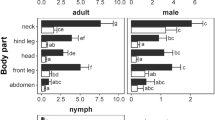Abstract
REPORTS on ticks, their feeding habits and their possible medicinal qualities have been reported early in historical time. Thus Pliny (A.D. 77) in his Historia naturalis referred to “an animal living on blood with its head always fixed and swelling, being one of the animals which has no exit [anus] for its food, it bursts with overrepletion and dies from actual nourishment. This [animal] never occurs on mules [it is] frequent on cattle, sometimes on dogs on which all [kinds of lice] are found; on sheep and goats [ticks] only are found”. Aristotle (355 B.C.) in Historia Animalium stated that “ticks are generated from couch grass”; “the ass has no lice or ticks, oxen have both … among dogs Cynorhaestes are plentiful”, Cynorhaestes being interpreted as meaning ricinus by Theodorus Gaza and considered as a “disgusting parasitic animal”. Later (c. 200 B.C.) M. Porcius Cato referred to treatments whereby “there will be no sores and the wool will be more plentiful and in better condition and the ticks (ricini) will not be troublesome”.
This is a preview of subscription content, access via your institution
Access options
Subscribe to this journal
Receive 51 print issues and online access
$199.00 per year
only $3.90 per issue
Buy this article
- Purchase on Springer Link
- Instant access to full article PDF
Prices may be subject to local taxes which are calculated during checkout
Similar content being viewed by others
References
Säve-Söderbergh, T., Four Eighteenth Dynasty Tombs (Private Tombs at Thebes i) (Griffiths Institute, Oxford, 1957).
de Garis Davies, N., Metropolitan Mus. Art Bull., 2, 51 (1932).
Stevensen Smith, W., Art and Architecture of Ancient Egypt, Pelican Books, London (1958).
Author information
Authors and Affiliations
Rights and permissions
About this article
Cite this article
ARTHUR, D. Ticks in Egypt in 1500 B.C.?. Nature 206, 1060–1061 (1965). https://doi.org/10.1038/2061060a0
Issue Date:
DOI: https://doi.org/10.1038/2061060a0
This article is cited by
-
The enigma of the dog mummy from Ancient Egypt and the origin of ‘Rhipicephalus sanguineus’
Parasites & Vectors (2014)
Comments
By submitting a comment you agree to abide by our Terms and Community Guidelines. If you find something abusive or that does not comply with our terms or guidelines please flag it as inappropriate.



